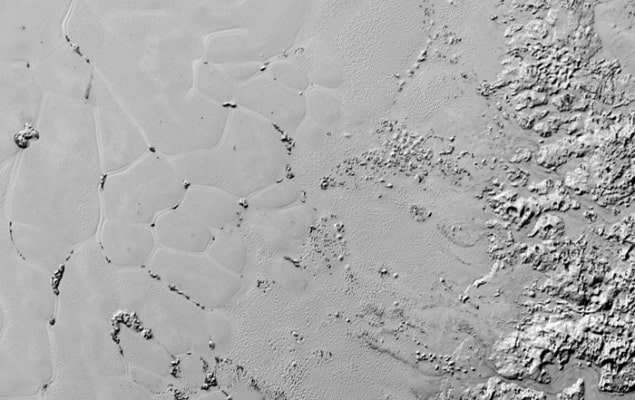
The patchwork of polygons on the surface of a vast plain of ice on Pluto is created by heat upwelling from the interior of the dwarf planet. That is the conclusion of two independent teams of scientists that have combined data from NASA’s New Horizons mission with computer simulations to gain a better understanding of Sputnik Planum – the flat region where the mysterious polygons exist. One important consequence of the convection process is that the surface of Sputnik Planum could be less than one million years old, making it one of the newest known surfaces in the solar system.
NASA’s New Horizons spacecraft reached Pluto in July 2015, making it the first mission to explore the dwarf planet. The spacecraft has since provided scientists with a wealth of information about Pluto and its moons as well as the first images of Pluto’s icy surface, which captured the imagination of scientists and the public alike.
Sputnik Planum, which is an ice-filled basin that occupies an area of about 900,000 km2, makes for a particularly interesting feature. The surface of the ice – which is believed to be mainly nitrogen – appears to be broken up into a collection of polygon-shaped tiles, each of which measure anywhere from 10–40 km across. The polygons are not flat – rather their centres rise up tens of metres above their edges to create a gently rolling icescape.
Radioactive heating
Nitrogen has a melting point of 67 K, which is well above Pluto’s surface temperature of 36 K – and therefore the surface of Sputnik Planum should be solid. However, Pluto is believed to have a core containing radioactive elements that generate heat as they decay. Nitrogen ice is a poor conductor of heat, so this radioactive heating should make lower regions of the nitrogen significantly warmer than the surface.
William McKinnon and colleagues on the New Horizons Geology, Geophysics and Imaging Theme Team reckon that the ice temperature below the surface is high enough that the nitrogen is partially melted and can flow like a viscous fluid. This would allow heat to be transferred upwards by the process of convection. This involves warm nitrogen slowly rising to the surface, where it cools and then falls back down. For convection to occur, the ice must self-organize into an array of convection cells – and the New Horizons team believes that each polygon corresponds to a cell.
Low-speed convection
Working independently, Alexander Trowbridge and colleagues at Purdue University came to the same conclusion after creating their own computer model of the convection process. They calculate that the convection velocity is about 1.5 cm per year. This means that the surface of Sputnik Planum is about one million years old, which is consistent with the lack of craters on the surface of the ice. This estimate is in broad agreement with calculations made by McKinnon and colleagues, who suggest that the surface is about 500,000 years old.
While the two teams agree that convection is shaping the surface of Sputnik Planum, they disagree on some important parameters. Trowbridge and colleagues, for example, argue that the size of the polygons suggests that the depth of the ice is at least 10 km throughout the plain. However, McKinnon and colleagues point out that “sluggish lid” convection could be occurring – whereby ice near the surface is significantly cooler than that in the interior. The result is convection cells that are much wider than they are deep, leading to an ice depth of only around 3–6 km.
The thickness of the ice has an important bearing on how the basin underlying Sputnik Planum was formed. McKinnon’s team points out that 3–6 km of ice is consistent with the basin being formed by a meteorite impact. The formation of a basin capable of holding 10 km of ice, however, would probably involve more complex geophysical processes. Another open question is how all that nitrogen settled into the basin in the first place. While the total amount of nitrogen on Pluto is what planetary scientists would expect, exactly how so much of it ended up in Sputnik Planum remains a mystery and could be related to an as-yet-unknown major event in the history of the dwarf planet.
Both groups report their results in Nature.



